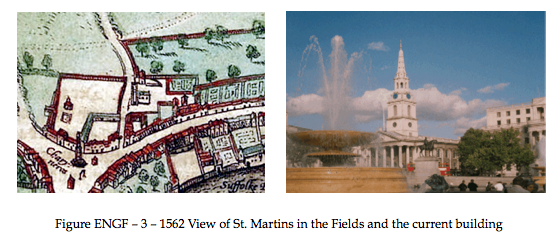Early English Forehand Families
Though apparently an Irish name, some of the earliest known records of a Forehand come from England. It is very possible the Forehand families present in England were simply immigrants from Ireland. However, we can not know this for certain. Oddly enough, though the records are early, they still do not pre-date the presence of a Thomas Forehand in Henrico County, Virginia.
Searching English records yields the earliest known marriage record of any Forehand family. On June 22, 1672, Gervas Forehand of Stableford (a village in Staffordshire) married Ann Bush in Nottinghamshire. The marriage took place at Saint Mary the Virgin in Bunny (figure ENGF-1). The cathederal was sometimes called the “Cathederal in the Woods” and was constructed in the 13th century. At this point, this church is probably the oldest surviving structure that we know a Forehand was physically present though I often wonder if and am quite sure there is an old house in England or Ireland that was perhaps an early Forehand residence. Perhaps one day we will know.
One of the earliest English documented Forehand records is the marriage of Thomas Forehand to Sabry Lane on August 12, 1686 in Saint Marylebone, Saint Marylebone Road, London. Saint Marylebone, a church in London, dates to the 1200’s. However, it has been destroyed and rebuilt at least four times with the present church having been built during the early 1800’s. The building Thomas and Sabry were married was built circa 1400. Interestingly enough, it is also this church were Francis Bacon was married in 1606. The interior of the church from this time period was portrayed by William Hogarth in the marriage scene from his famous series, “A Rakes Progress (1735)” (figure ENGF-1).
Later church records also help us identify their children as detailed christening records exist. The following children of Thomas and Sabry (sometimes spelled Cebre) Forehand as as follows and were all christened at Westminster, Saint Martin in the Fields, London:
•Thomas Forehand was christened on 10 Jul 1687
•William Forehand was christened on 5 May 1689
•Mary Forehand was christened on 4 Jan 1690
•James Forehand was christened on 30 Jan 1692 (mother’s name was spelled “Zipporah”)
•Sabra Forehand was christened on 18 May 1694
•Chillen Forehand was christened on 21 Jan 1696
•Jane Forehand was christened on 27 Mar 1699
•Elizabeth Forehand was christened on 3 Nov 1700
•Judith Forehand was christened on 22 Feb 1701
•John Forehand was christened 30 Jul 1704
With all these christenings occurring at this specific location, it is worthy of a short “history” lesson. Saint Martins is located in Westminster, London. There is no official reference to a church on the site of St Martin’s until Norman times, when in 1222 a dispute was recorded between William, Abbot of Westminster, and Eustace, Bishop of London on the Bishop’s authority over the church. The Archbishop of Canterbury decided in favor of the abbot and St Martin’s, then surrounded by fields, appears to have been used by the monks of Westminster. While it has been suggested that there was a place of worship on the site prior to this date, there is little evidence to verify that this is true.
Sometime in 1542, Henry VIII, built a new church and extended the parish boundaries to keep plague victims from being carried through his palace. This was enlarged in 1607 at the cost of Prince Henry, the son of King James I.
In 1721, the church was pulled down and the current building (figure ENGF-3), designed by James Gibbs, was erected. Gibbs was a Scottish architect in the Italian Baroque tradition. Four years before beginning his work on the new St Martin’s he completed his Wren-influenced St Mary le Strand, which still stands today only a few yards from St Martin’s.




